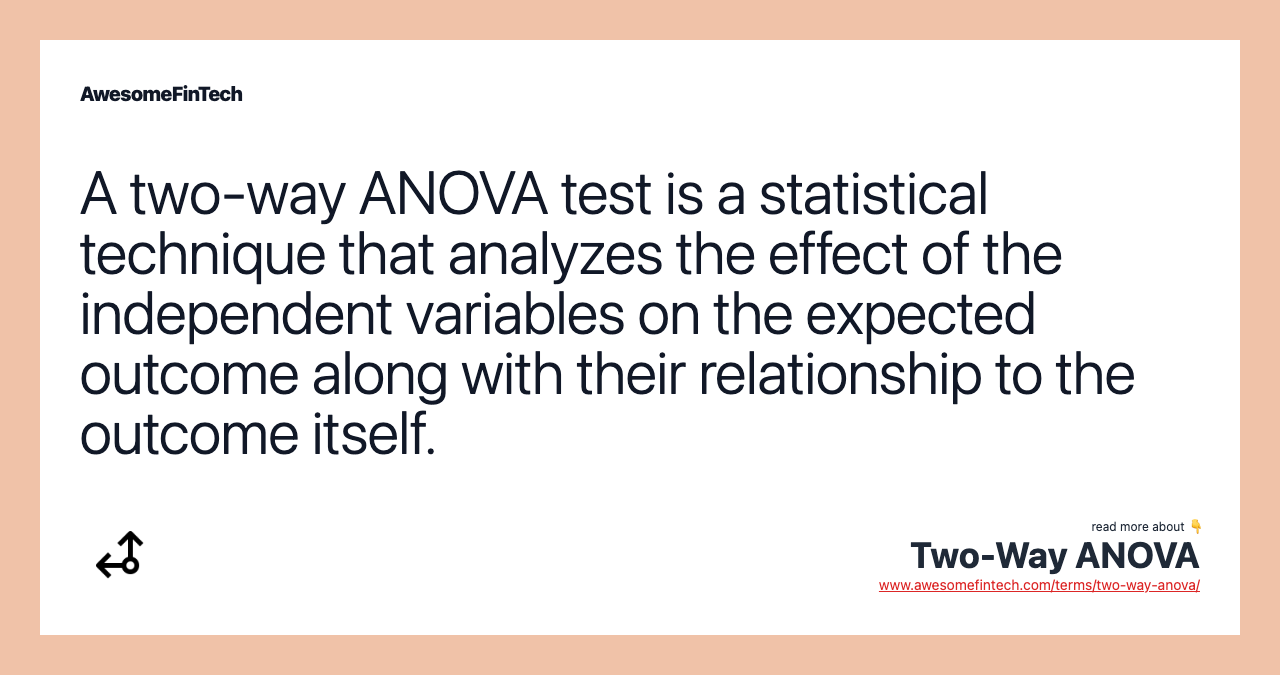Two-Way ANOVA
A two-way ANOVA is an extension of the one-way ANOVA (analysis of variances) that reveals the results of two independent variables on a dependent variable. A two-way ANOVA test is a statistical test used to determine the effect of two nominal predictor variables on a continuous outcome variable. A two-way ANOVA test is a statistical technique that analyzes the effect of the independent variables on the expected outcome along with their relationship to the outcome itself. A two-way ANOVA test analyzes the effect of the independent variables on the expected outcome along with their relationship to the outcome itself.

What Is a 2-Way ANOVA?
ANOVA stands for analysis of variance and tests for differences in the effects of independent variables on a dependent variable. A two-way ANOVA test is a statistical test used to determine the effect of two nominal predictor variables on a continuous outcome variable.
A two-way ANOVA tests the effect of two independent variables on a dependent variable. A two-way ANOVA test analyzes the effect of the independent variables on the expected outcome along with their relationship to the outcome itself. Random factors would be considered to have no statistical influence on a data set, while systematic factors would be considered to have statistical significance.
By using ANOVA, a researcher is able to determine whether the variability of the outcomes is due to chance or to the factors in the analysis. ANOVA has many applications in finance, economics, science, medicine, and social science.



Understanding 2-Way ANOVA
An ANOVA test is the first step in identifying factors that influence a given outcome. Once an ANOVA test is performed, a tester may be able to perform further analysis on the systematic factors that are statistically contributing to the data set's variability.
A two-way ANOVA test reveals the results of two independent variables on a dependent variable. ANOVA test results can then be used in an F-test, a statistical test used to determine whether two populations with normal distributions share variances or a standard deviation, on the significance of the regression formula overall.
Analysis of variances is helpful for testing the effects of variables on one another. It is similar to multiple two-sample t-tests. However, it results in fewer type 1 errors and is appropriate for a range of issues. An ANOVA test groups differences by comparing the means of each group and includes spreading out the variance across diverse sources. It is employed with subjects, test groups, between groups and within groups.
ANOVA vs. 2-Way ANOVA
There are two main types of analysis of variance: one-way (or unidirectional) and two-way (bidirectional). One-way or two-way refers to the number of independent variables in your analysis of variance test. A one-way ANOVA evaluates the impact of a sole factor on a sole response variable. It determines whether the observed differences between the means of independent (unrelated) groups are explainable by chance alone, or whether there are any statistically significant differences between groups.
A two-way ANOVA is an extension of the one-way ANOVA. With a one-way, you have one independent variable affecting a dependent variable. With a two-way ANOVA, there are two independents. For example, a two-way ANOVA allows a company to compare worker productivity based on two independent variables, such as department and gender. It is utilized to observe the interaction between the two factors. It tests the effect of two factors at the same time.
A three-way ANOVA, also known as three-factor ANOVA, is a statistical means of determining the effect of three factors on an outcome.
Related terms:
Analysis Of Variances (ANOVA)
Analysis of variances (ANOVA) is a statistical examination of the differences between all of the variables used in an experiment. read more
Analysis of Variance (ANOVA) & Formula
Analysis of variance (ANOVA) is a statistical analysis tool that separates the total variability found within a data set into two components: random and systematic factors. read more
Economics : Overview, Types, & Indicators
Economics is a branch of social science focused on the production, distribution, and consumption of goods and services. read more
Error Term
An error term is a variable in a statistical model when the model doesn't represent the actual relationship between the independent and dependent variables. read more
Social Sciences
Social sciences are a group of academic disciplines that examine society and how people interact and develop as a culture. read more
Statistical Significance
Statistical significance refers to a result that is not likely to occur randomly but rather is likely to be attributable to a specific cause. read more
Statistics
Statistics is the collection, description, analysis, and inference of conclusions from quantitative data. read more
T-Test
A t-test is a type of inferential statistic used to determine if there is a significant difference between the means of two groups, which may be related in certain features. read more
Three-Way ANOVA
The three-way ANOVA is used by statisticians to determine whether there is a three-way relationship among variables on an outcome. read more
Introduction to the Type 1 Error
A type I error is a kind of error that occurs when a null hypothesis is rejected, although it is true. Discover more about the type I error. read more